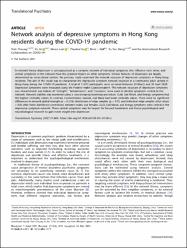Network analysis of depressive symptoms in Hong Kong residents during the COVID-19 pandemic
Künye
1 Cheung T, Jin Y, Lam S, Su Z, Hall BJ, Xiang Y-T. Network analysis of depressive symptoms in Hong Kong residents during the COVID-19 pandemic. Translational Psychiatry 2021; 11. doi:10.1038/s41398-021-01543-z.Özet
In network theory depression is conceptualized as a complex network of individual symptoms that influence each other, and central symptoms in the network have the greatest impact on other symptoms. Clinical features of depression are largely determined by sociocultural context. No previous study examined the network structure of depressive symptoms in Hong Kong residents. The aim of this study was to characterize the depressive symptom network structure in a community adult sample in Hong Kong during the COVID-19 pandemic. A total of 11,072 participants were recruited between 24 March and 20 April 2020. Depressive symptoms were measured using the Patient Health Questionnaire-9. The network structure of depressive symptoms was characterized, and indices of “strength”, “betweenness”, and “closeness” were used to identify symptoms central to the network. Network stability was examined using a case-dropping bootstrap procedure. Guilt, Sad Mood, and Energy symptoms had the highest centrality values. In contrast, Concentration, Suicide, and Sleep had lower centrality values. There were no significant differences in network global strength (p = 0.259), distribution of edge weights (p = 0.73) and individual edge weights (all p values > 0.05 after Holm–Bonferroni corrections) between males and females. Guilt, Sad Mood, and Energy symptoms were central in the depressive symptom network. These central symptoms may be targets for focused treatments and future psychological and neurobiological research to gain novel insight into depression


















